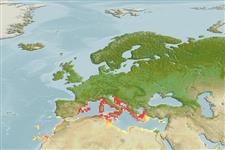Environment: milieu / climate zone / Tiefenbereich / distribution range
Ökologie
seewasser demersal; tiefenbereich 5 - 80 m (Ref. 4696), usually 5 - 30 m (Ref. 27115). Subtropical; 15°C - 20°C (Ref. 27115); 45°N - 27°N, 19°W - 36°E
Eastern Atlantic: northern Spain to Madeira and the Canary Islands; also in the Mediterranean.
Size / Gewicht / Alter
Geschlechtsreife: Lm ? range ? - ? cm
Max length : 10.0 cm TL Männchen/unbestimmt; (Ref. 4696)
Rückenflossenstacheln (insgesamt) : 7; Rückenflossenweichstrahlen (insgesamt) : 14; Afterflossenstacheln: 1; Afterflossenweichstrahlen: 13. Distinguished by having the following characteristics: Reduced suckers (Ref. 92840).
Body shape (shape guide): fusiform / normal.
Occurs in deeper inshore waters; over rocky substrates with algae and gorgonians (Ref. 4696). Abundant populations on coasts with steep bedrock. A shy species and difficult to collect due to long flight distances and hiding in deep clefts (Ref. 87880). Macrobenthos feeder on hard substrates ingest also shelled organisms like molluscs and echinoderms (Ref. 92840).
Life cycle and mating behavior
Geschlechtsreife | Fortpflanzung | Ablaichen | Eier | Fecundity | Larven
Miller, P.J., 1986. Gobiidae. p. 1019-1085. In P.J.P. Whitehead, M.-L. Bauchot, J.-C. Hureau, J. Nielsen and E. Tortonese (eds.) Fishes of the North-eastern Atlantic and the Mediterranean. Volume 3. UNESCO, Paris. (Ref. 4696)
IUCN Rote Liste Status (Ref. 130435: Version 2025-1)
Bedrohung für Menschen
Harmless
Nutzung durch Menschen
Fischereien: kommerziell; Aquarium: Kommerziell
Tools
Zusatzinformationen
Download XML
Internet Quellen
Estimates based on models
Preferred temperature (Ref.
123201): 15.6 - 19.4, mean 18.1 °C (based on 68 cells).
Phylogenetic diversity index (Ref.
82804): PD
50 = 0.5000 [Uniqueness, from 0.5 = low to 2.0 = high].
Bayesian length-weight: a=0.01023 (0.00477 - 0.02194), b=3.01 (2.83 - 3.19), in cm total length, based on LWR estimates for this (Sub)family-body shape (Ref.
93245).
Trophic level (Ref.
69278): 3.0 ±0.35 se; based on food items.
Widerstandsfähigkeit (Ref.
120179): hoch, Verdopplung der Population dauert weniger als 15 Monate. (Preliminary K or Fecundity.).
Fishing Vulnerability (Ref.
59153): Low vulnerability (10 of 100).
🛈
